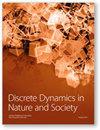A Model for the Propagation and Control of Pulmonary Tuberculosis Disease in Kenya
IF 1.3
4区 数学
Q3 MATHEMATICS, INTERDISCIPLINARY APPLICATIONS
引用次数: 0
Abstract
Pulmonary tuberculosis is among the leading infectious diseases causing mortality worldwide. Therefore, scaling up intervention strategies to reduce the spread of infections in the population is imperative. In this paper, a population-based compartmental approach has been employed to formulate a mathematical model of pulmonary tuberculosis that incorporates an asymptomatic infectious population. The model includes asymptomatic infectious individuals since they spread infections incessantly to susceptible populations without being noticed, thus contributing to the high rate of infection transmission. Qualitative and numerical analyses were performed to determine the impact of various intervention strategies on controlling infection transmission in the population. Sensitivity and numerical results indicate that increasing screening of latently infected and asymptomatic infectious individuals reduces infection transmission to the susceptible population. Numerical results demonstrate that the combination of vaccination, screening, and treatment of all forms of pulmonary tuberculosis is the most effective intervention in decreasing infection transmission. Furthermore, a combination of screening and treatment of all forms of pulmonary tuberculosis proves more effective than a combination of vaccination and treatment of symptomatic infectious individuals alone. Treating the symptomatic infectious population alone is identified as the least effective intervention for curtailing infection transmission in the susceptible population. These study findings will guide healthcare officials in making decisions regarding the screening of latently infected and asymptomatic infectious pulmonary tuberculosis patients, thereby aiding in the fight against epidemics of this disease.肯尼亚肺结核病传播与控制模型
肺结核是导致全球死亡的主要传染病之一。因此,加强干预策略以减少感染在人群中的传播势在必行。本文采用基于人群的分区方法,建立了一个包含无症状感染人群的肺结核数学模型。该模型包括无症状感染者,因为他们会在不被注意的情况下不断向易感人群传播感染,从而导致高感染传播率。我们进行了定性和数值分析,以确定各种干预策略对控制人群感染传播的影响。灵敏度和数值结果表明,加强对潜伏感染者和无症状感染者的筛查可减少向易感人群的感染传播。数值结果表明,结合疫苗接种、筛查和治疗各种形式的肺结核是减少感染传播最有效的干预措施。此外,结合筛查和治疗所有形式的肺结核比单独接种疫苗和治疗有症状的感染者更有效。单独治疗有症状的感染人群被认为是遏制易感人群感染传播的最无效干预措施。这些研究结果将指导医疗保健官员在筛查潜伏感染者和无症状传染性肺结核患者方面做出决策,从而帮助抗击这种疾病的流行。
本文章由计算机程序翻译,如有差异,请以英文原文为准。
求助全文
约1分钟内获得全文
求助全文
来源期刊

Discrete Dynamics in Nature and Society
综合性期刊-数学跨学科应用
CiteScore
3.00
自引率
0.00%
发文量
598
审稿时长
3 months
期刊介绍:
The main objective of Discrete Dynamics in Nature and Society is to foster links between basic and applied research relating to discrete dynamics of complex systems encountered in the natural and social sciences. The journal intends to stimulate publications directed to the analyses of computer generated solutions and chaotic in particular, correctness of numerical procedures, chaos synchronization and control, discrete optimization methods among other related topics. The journal provides a channel of communication between scientists and practitioners working in the field of complex systems analysis and will stimulate the development and use of discrete dynamical approach.
 求助内容:
求助内容: 应助结果提醒方式:
应助结果提醒方式:


